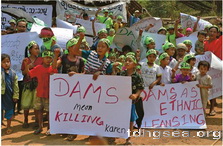
ABOUT US The ‘Our Rivers, Our Life’ campaign is a regional biodiversity campaign in South East Asian countries including Myanmar, Cambodia, Indonesia, Laos, the Philippines, Thailand and Vietnam. It is implemented by the terre des hommes regional working group on biodiversity. The campaign aims to contribute to the protection and conservation of the rivers and biodiversity in South East Asia with the active participation of children and youth. In any large scale-development, children are always the most affected as they are the most vulnerable group in a community.
The seven country members work to protect the health and biodiversity of 11 rivers: the Salween (Myanmar), Mekong (Thailand, Cambodia, Laos, Vietnam ), Mae Kok, Nan, Mae Ping and Mae ing (Thailand), Vaiko (Cambodia), Agusan and Rio Grande De Mindanao (Pulangi) (Philippines), Cisadane (Indonesia), the Dong Nai and Saigon (Vietnam) and the Xedone and Xelanong (Laos).
WHY DO WE CAMPAIGN
Throughout Southeast Asia, river ecosystems, land, local livelihoods, and indigenous cultures are being threatened by large-scale development such as mining, dams, large-scale plantations and water pollution. Millions of riverine communities and those who live near large scale development sites are facing many difficulties including displacement, loss of livelihood, health problems, and cultural disintegration. Local and indigenous people are commonly excluded from any meaningful participation in decision making about the management of their natural resources.
ABOUT THE REGIONAL WORKING GROUP ON BIODIVERSITY
Vision
Local and Indigenous people in South East Asia actively take part in the protection of biodiversity to maintain the region’s rich ecosystem, cultures and local livelihood.
Mission
· Support community biodiversity conservation initiatives
· Promote cultural diversity which supports biodiversity recovery
· Raise public awareness through information, education and communication
· Develop a strong network at local, national and international levels
· To stop destructive biodiversity development
· To involve children and youth in conserving biodiversity
Objectives
1. To raise awareness and train children and youth on river and biodiversity issues
2. To form theatre and artist groups to raise awareness and mobilize communities and individuals about river and biodiversity issues
3. To increase media coverage on biodiversity and river issues
4. To established and strengthen river watch groups on 11 rivers
5. To influence policy and local laws to protect biodiversity and rivers
6. To effectively maintain coordination and communication among RWG members and project partners
7. To promote and distribute campaign materials throughout the region



What is Biodiversity and why is it important?
BIOLOGICAL diversity or biodiversity is the variety of genetic material, species and ecosystems found in nature. Collectively, biodiversity stabilizes our atmosphere and climate, protects water catchments and renews the soil. It also helps to keep ecosystems ‘adaptable’ should environmental conditions change abruptly.
The diversity of nature is the foundation of the word’s material wealth. From biodiversity we develop food crops and derive the raw inputs and genetic materials for industry, agriculture and medicine. The benefits are worth many billions of dollars each year, and people spend further billions to appreciate nature and its diversity through tourism and recreation.
The challenge of biodiversity is to conserve the flora and fauna, for the long and short term needs of the people, by protecting indigenous species within the region and protecting the wisdom of the people. Protecting biodiversity is protecting the environment as these are inextricably linked.
Cultural and biological diversity are also strongly interconnected and are the basis for sustainable development and management. A loss in cultural diversity throughout the world, results in the loss of traditions, practices and ways of lives for ethnic groups. Ecosystem are being lost or changed, species face extinction everyday and genes are being modified for the “benefit” of human development. In order to avoid this global homogenization and disintegration both in terms of cultural and natural diversity, local cultures need to be strengthened and natural resources protected.



Members of Southeast Asia Regional Working Group:
Cambodia Santi Sena
Indonesia The Indonesian Institute for Forest and Environment (RMI)
Laos Our Village Association for Community Development
Myanmar Karen Environmental Social Action Network (KESAN) and Karen River Watch
Philippines PANALIPDAN
GITIB, Inc.
Thailand Association for Community Ecology Development (ACED)
Vietnam Agricultural Extension Centre of Ho Chi Minh City
Other terre des hommes partners and allied networks who are engaged in biodiversity and river issues are also part of this campaign.
